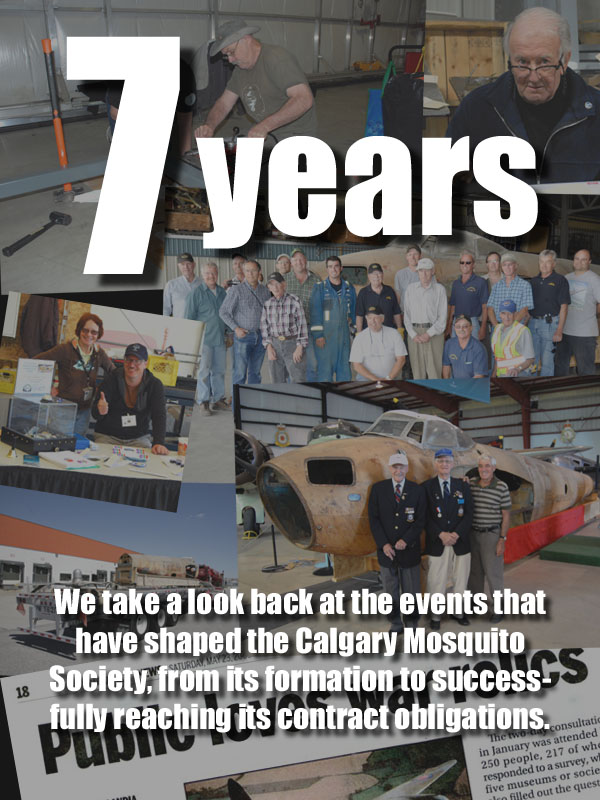

Look at the histories of many non-profit organizations and you'll be hard pressed to find serious information about how, or why, each one was founded. In many cases, even the identities
of the founders or the challenges they faced have long been forgotten.
Now that the Calgary Mosquito Society has passed its last significant hurdle - fundraising - we felt it was time to permanently record the hard work that so many people invested into our
cause. The natural choice to write this history was Richard de Boer. Not only is Richard the CMS's President, he's been watching the City of Calgary's Mosquito since he was a teenager. He
watched over it at the Aerospace Museum, and he's opposed every sale, attended every meeting, and spoken to thousands of people to ensure it stays in Calgary. In short, he started running
with the torch and the rest of us formed the CMS behind him.
What will the CMS look like in five or ten years? We can't say at this point, but the two planes we started out to preserve will be on display for people to enjoy. What we do want, is for
people to remember that no matter the challenge, despite the odds and the naysayers, we pushed forward and reached our goal.
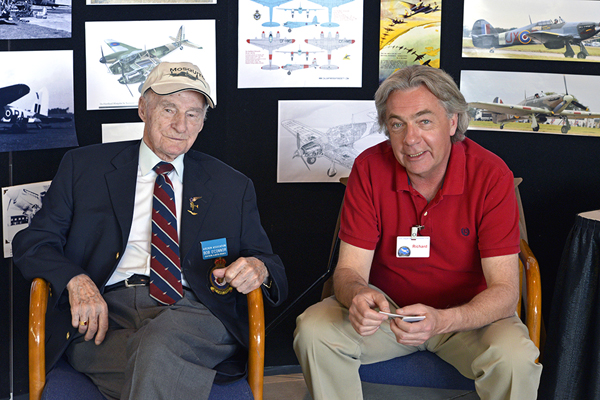
Bob O'Connor and Richard de Boer, two men from different generations who were brought together because of their mutual love of the Mosquito. Right up until his passing in 2013, Bob was a whole-hearted supporter of the CMS, a fixture at our public events and our Vice-President. (Paul Gary)
It started seven years ago with a call from a 'friend'. Said 'friend' had heard that there might be another attempt to sell the City owned Mosquito to an overseas buyer.
Yes, 'another' attempt. In 2005 an aircraft sales agent in Ontario had put a deal together to trade the Mosquito for a Starfighter and $100,000. It took Bob O'Connor, Keith Holden and I just
six months to get the province to tell the city that it was a bad idea, which is why in 2007 the deal was being done behind closed doors. If no one knows, then no one can interfere.
When I wrote to the people supporting the sale, I was told to mind my own business. I wrote back and got no answer. So then I figured that we should deal with the airplane owners. I put an
info package together for every member of city council suggesting that they were acting on incomplete and skewed information. To my surprise, a couple Aldermen actually called me at home.
One confirmed that a deal was on the go and that it could not be discussed. He asked if I considered going public with my concerns. I took it as advice and wrote a press release to throw the
issue into the spotlight. It was inflammatory and it worked: both papers, all three TV networks and five radios stations showed up for my announcement. By the weekend it had gone national.
Then the phone calls and emails started from people in Calgary, across the country and around the world. To date, they haven't stopped. It's given me a tremendous circle of friends who share
in our passion and vision. That is cool.
What was less cool was getting a registered letter advising me that my membership in the aviation museum was under review by the board and that I would be given the opportunity to 'defend'
my actions. The cool part of that? The 25 people who showed up to speak on my behalf!
The city suspended the impending sale and decided to hold an open house to find out what people in Calgary wanted to do with the airplanes. A bunch of us attended and spoke with people who
came in to insure that they had a balance of information and could respond to some of the skewed questions. 88% of respondents, as their first choice, told the City that they wanted to see
both the Mosquito and Hurricane kept and restored.
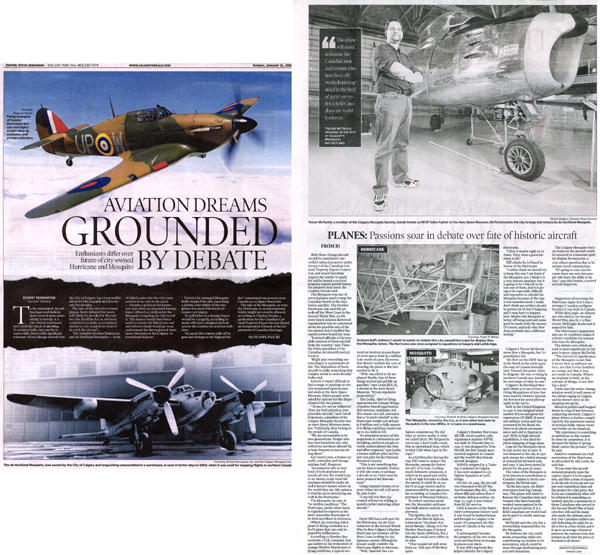
The first newspaper article relating to the Mosquito and Hurricane appeared on January 11, 2008. It featured Trevor M., an early CMS member who opposed the sale. (Calgary Herald)

This article, which appeared in the October 3, 2008 Calgary Herald included Alderman Gordon Lowe's infamous "$15 million" quote. (Calgary Herald)
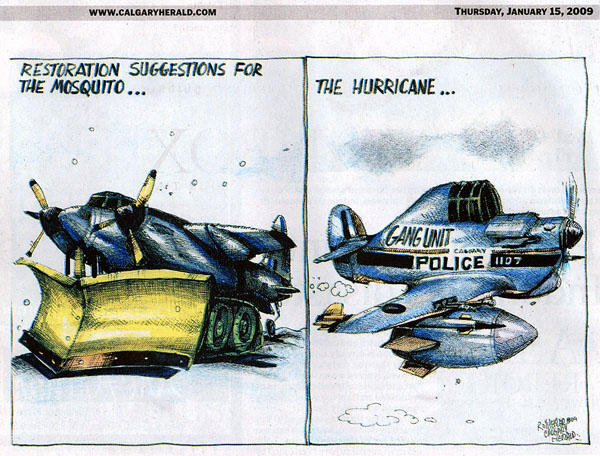
We even made the political cartoons, showing alternate uses for the planes battling Calgary's snow removal and gang problems - January 15, 2009. (Calgary Herald)
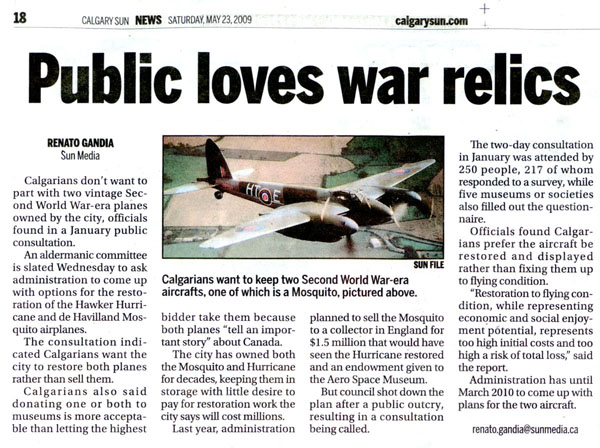
This article, from the May 23, 2009 Calgary Sun summed up the results of all the public houses. "Officials found Calgarians prefer the aircraft be restored and displayed rather than fixing them up to flying condition." (Calgary Sun)
One of the very frustrating challenges in the first year and more was that we didn't know who the buyer was. A warbird guy? A museum? A big name in the business? An investor? No idea. Then
two friends from Nanton travelled to England on a search for Lancaster parts. While there they chanced across a flying Hurricane, a chatty mechanic and book that made certain references to
Calgary. They put 2 and 2 together and called me. Ah ha! We were no longer playing chess in the dark with an unknown opponent.
But in this process, we made some determined enemies. A succession of people told the now identified buyer in England that they would carry his torch for him. They showed up at City Council
meetings to say that the Mosquito could not be restored in Canada because we didn't have the experience or skills. They wrote articles to aviation magazines. One even travelled to England to
meet the buyer. Another distributed letters to hundreds of people denouncing us and our intentions. The 'buyer' in England wrote to the editor of a local daily paper and in turn the editor
wrote a long piece supporting the sale. In an international aviation magazine a Calgary detractor accused us of being nothing more than "over enthusiastic amateurs". (I still want to get
that on a good golf shirt below our logo...).
It became apparent that a bunch of people repeating the phrase 'don't sell the Mosquito' was not going to sway city council, it was decided that we need to offer council an attractive option
to selling the airplane. The Calgary Mosquito Aircraft Society was born. Our proposal to the City, in principle, was simple: We'll do the restoration. We'll do all the fundraising. We'll
manage the display of the airplane. You retain ownership. If we fail, take them back and do whatever you want with them. All we are asking for is the chance to do something, at no cost to
the City. It was a Win/Win, no lose proposition.
We put our first table top trifold display together and set up a single table in the Bomber Command Museum during one of their special event days. I treasure the picture of Bob O'Connor and
me standing on either side of that table. We went to the Lethbridge Air Show and a dozen people joined us, paying their own way and spending the day under a cheap and nasty 'tent' that
barely survived the late afternoon thunderstorm. We sold memberships. We talked to anyone who would listen. We went to schools and libraries and museums and endless service club meetings to
spread the gospel of the Mosquito.

Bob and Richard man our first information booth at the Bomber Command Museum. Just look a the display board, you can tell we were a grass roots organization. (Peter Cromer)
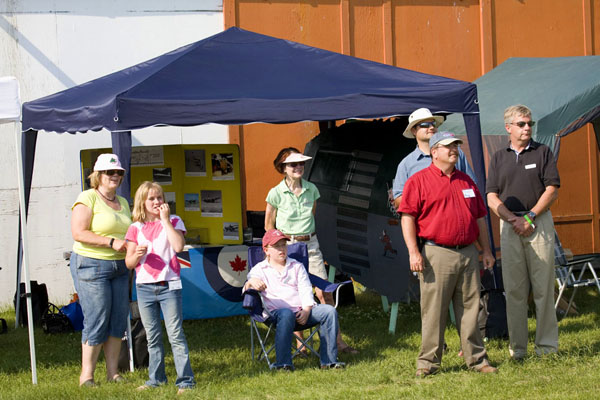
The CMS was able to participate in all three Airdrie Airshows (2009, 2011 and 2013). Our minimalist display made its final appearance at the 2009 show. (Peter Cromer)
We went to the meetings of the committee of City Council tasked with making a recommendation on what to do with the airplanes. Our supporters would take a day off work, dress up and sit in
the basement of City Hall all day listening to endless hours of procedural issues just for the chance to speak for five minutes in support of our efforts. And there were the seemingly
endless Requests for Information and Requests for Proposals from the City. We needed to fill binders full of information on our actual plans and the background and skills of our supporters
and potential sources of funding and full restoration plans for airplanes some of us had never even seen. I learned what GANTT charts were and what 'Best Practices in the Industry' meant.
And at every turn, people like Bonnie and Peter showed up with the necessary skills to allow us to supply what was asked for.
We asked you to write letters to Council, to the Mayor and to the newspapers. Wow, did people write. And it worked. One City Alderman said he had more mail on the Mosquito issue than on
anything else before council.
At some point it became apparent that if we focused just on the Mosquito that our buyer in England still had a toe in the door with his offer to have the Hurricane restored. At a board
meeting we discussed our options. Optimism and naivety won again. In for a penny, in for a Hurricane we decided. Sure, why not?
Since we were a new organization, we had no previous track record to show the City; no laurels to rest on, so we created partnerships with those who did. The board members of the Bomber
Command Museum in Nanton offered the space in which to restore the Mosquito. It fit the theme of their collection and would be a draw to their museum. WestJet offered space in their hangar
for us to work and put it in writing for us. That carried a lot of weight in certain quarters. We talked to Historic Aviation Services about working on the Hurricane as they had already done
one and were the company trusted by the provincial transportation museum to restore all of their airplanes. Trevor asked for letters of support from aviation companies and we got them.
We joined the Alberta Museum Association and the Canadian Museums Association and the Association of Canadian Aviation Museums. And we started attending conferences; Jack and Scott went to
the Smithsonian organized Mutual Concerns of Air and Space Museums on their own dime. Jack has attended virtually every one since we were formed.
Jack and Colette were the first members of our board to visit and make contact with the De Havilland Heritage Center in Hatfield, England and immediately gained their enthusiastic support.
They are regular sources of information and inspiration to our project today.
Meanwhile, Mosquito fans the world over were anxiously watching the efforts of AvSpecs in New Zealand to rebuild to flying status Mosquito KA114 for Jerry Yagen of Virginia Beach, VA. When a
Calgary Alderman, in an attempt to frighten people with outlandish cost numbers, claimed to know of a Mosquito in New Zealand that was going to cost $15,000,000 to restore, we got a voice
mail from Jerry Yagen the next day. "$15M?!?! What horse s--t! Call me at my office tomorrow. I'll tell you what I paid for every part of my Mosquito." I called and he did. He had pulled
out a folder of receipts and went over every item he had acquired from every source to rebuild KA114 to a flying airplane. The total bill was around $2.5M. Another untruth bit the dust.
Our efforts caught the ear of more people in England and we were invited to make a presentation to the Mosquito Aircrew Reunion to be held at the RAF Club in London in April 2011. It was a
great trip that forged very strong and supportive bonds. As a consequence the next summer we hosted the visit of Mosquito pilot and author S/L Joe Patient DFC, then 95 years old along with
David Coeshall and his wife Jan who were co-organizers of the reunion and some of the biggest and most active Mosquito supporters in the UK.
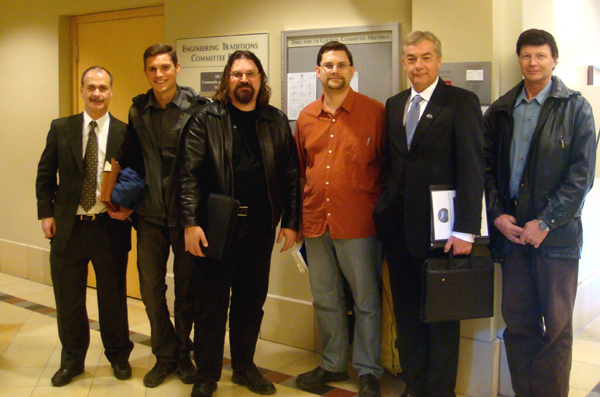
A small number of very happy CMS members and supporters who attended the December 2010 committee meeting in which the sale was finally cancelled and the CMS emerged as the forerunner in seeing the restorations through. (CMS)
Success came in steps. On December 7, 2010 we met with newly elected Mayor Nenshi at his request. The next day the committee of City Council finally made a decision which came after a
lengthy cat fight with supporters of the sale. Returning from lunch the committee of seven Councilors decided unanimously to recommend to Council that the City retain both the Mosquito and
Hurricane and that they partner with a not for profit group to see that both were restored.
Then came the double whammie. The committee suggested that the city put up $800,000 in matching funds toward the restoration of both airplanes. It completely floored us as we had never asked
for a dime. We were commended by several members of the committee for our passion and told that rarely to topics and meetings see so much enthusiasm.
To make it fair to all concerned though, they didn't say which group the City should partner with. The field suddenly got very crowded with museums and businesses willing to undertake the
restorations. Amazing what a little money on the table can do.
On February 14, 2011 a full sitting of council sat to consider the recommendation of their subcommittee. The motion to keep the airplanes and partner with a not for profit group passed by a
vote of 12 to 2. The motion to put up $800,000 passed 10 to 4. The Mayor stood and chastised Council for voluntarily offering money to a group that had not asked for a nickel.
Next it was time for the City to decide whom to partner with. Out went yet another call for proposals. They were weighed, studied and evaluated. On December 23, 2012, the City announced that
our bid had won!
'Okay, hand us the keys to the warehouse and away we go', thought I. Silly me. Next came the contract process. That took seven months and was one of the most painful parts of this seven year
process. It was finally signed on August 1, 2012. We moved the Mosquito to Nanton on August 11. Waiting for us in the parking lot on a Saturday afternoon was Alderman Brian Pincott who drove
down on his own time just to witness our moment of triumph. Now that is cool.

After being selected by the City the CMS was permitted to inspect the airplanes in a warehouse. After decades of searching, Richard was finally able to hold the control yoke of a real DH Mosquito. (Trevor McTavish)

Finally the Mosquito was permitted to move, and Barry D. helps secure parts on the first truck to leave the warehouse. (CMS)
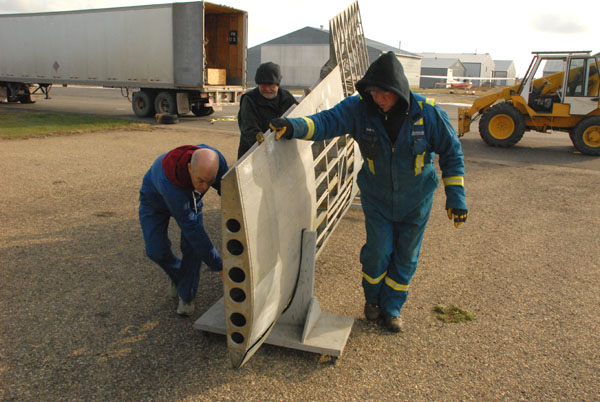
A few weeks later, the Hurricane moved to Wetaskiwin. (Richard de Boer)
Robyn did a stellar job organizing the party that followed two weeks later. The author of the City funding motion, Alderman Jim Stevenson, attended the dinner on Friday night and came back
for speeches and ceremonies the next day. That is the sort of behaviour that makes it hard to be cynical about politicians. It was a grand weekend with special guests and acknowledgments
from many people and organizations.
The next week, our serious attempts at fundraising started. Two years, less six weeks from signing the contract that required us to have all our money in the bank, we did it. What put us
over the top was our appeal to our very own members who were generous to a fault and the approval of the Calgary Foundation on a grant of $60,000 for our educational work.
More money than we needed in less time than we were given.
We have won every fight and cleared every hurdle. It's been an education and an honour to be the guy at the front of the parade waving the banner. Thank you.
Richard de Boer
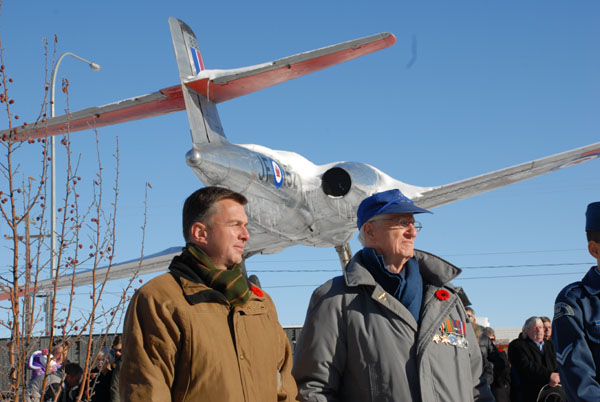
Stephane G. and Pat A. attend a Remembrance Day ceremony in Nanton. Pat was a wartime navigator on 410 Sqd. Mosquitoes, and supported the CMS until his passing in 2013. (Richard de Boer)
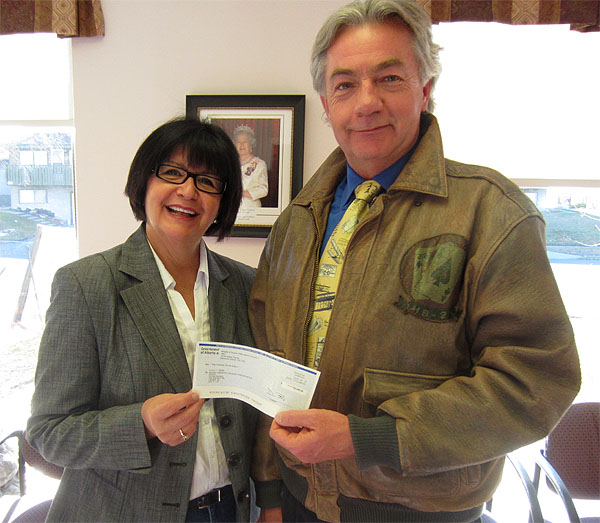
Ricahrd accepts a cheque from MLA Yvonne Fritz on behalf of the Community Initiative Program. (CMS)
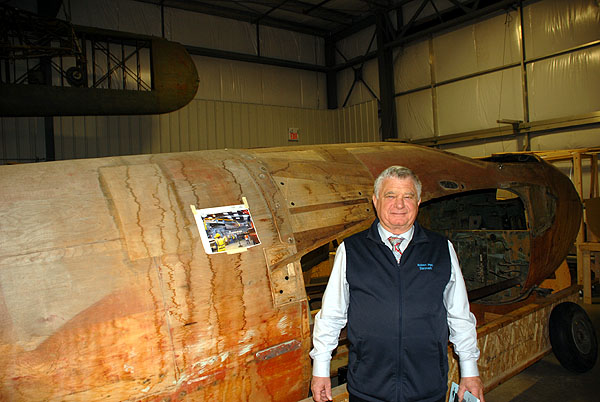
Having a Mosquito means that hundreds of Mosquito enthusiasts now want to see our plane. Robert Peel, for instance, travelled all the way from Denmark for a visit in 2012. (Richard de Boer)
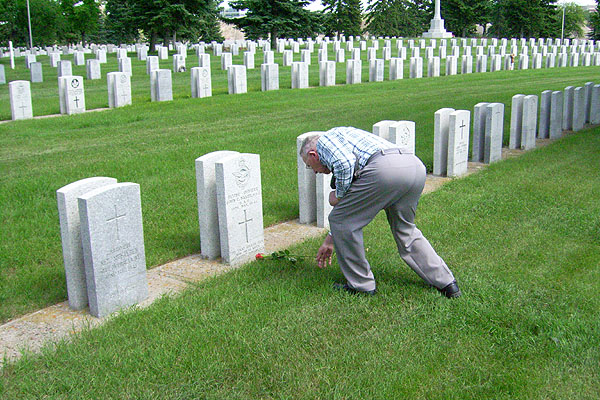
But it hasn't always been happy. In 2012, 95 year old S/L Joe Patient DFC returned to Alberta to revisit the bases he learned to fly at. He also visited his friend, F/O John Baker DFC and Bar, who died in the 1945 crash of F for Freddie and is buried in the Burnsland Cemetery. (Richard de Boer)